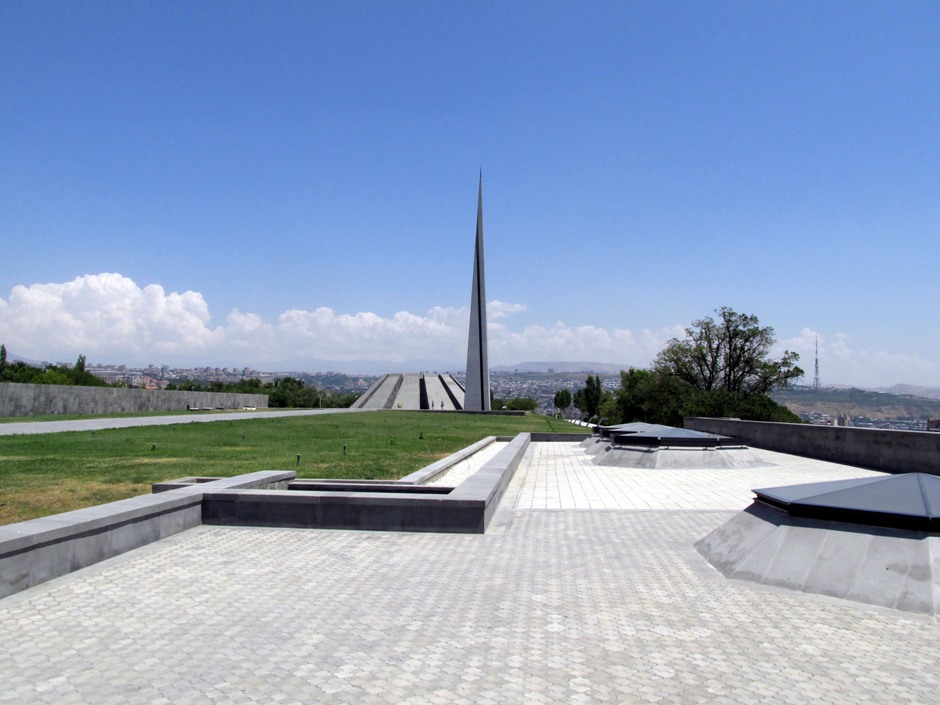On a hilltop just outside the city centre of Yerevan is the Armenian Genocide Memorial complex (Tsitsernakaberd). It was built in 1967 and is dedicated to the victims of the Armenian Genocide which began on 24 April 1915.

The memorial consists of a 44m tall stele, symbolising the national rebirth of Armenians. 12 slanting slabs are positioned in a circle, representing the 12 lost provinces of Armenia which now lie in Turkey. Between the slabs, steps go down to the centre of the circle to an eternal flame dedicated to the estimated 1.5 million people killed during the Armenian Genocide. Also forming the memorial is a 100m wall with the names of places where massacres and deportations of Armenians are known to have taken place.








Before approaching the memorial from the main entrance, the visitor walks through an arboretum area, where trees have been planted by many foreign dignitaries, including Vladimir Putin, Jacques Chirac and Pope John Paul II. On the right and positioned below ground, so as not to interfere with the monument is the Armenian Genocide Museum-Institute. It opened its doors in 1995 on the 80th anniversary of the genocide. The museum takes you through a history of the tragic events as they unfolded in chronological order with multilingual wall displays, various artefacts and reproduced newspaper/magazine reports from the time.








April 24th is considered worldwide Armenian Genocide Remembrance Day. In 1965, thousands of Armenians marked the anniversary by taking to the streets of Yerevan and demonstrating. Soviet troops attempted to restore order, but in order to stop a repetition, the Kremlin agreed to build the memorial complex which was completed two years later.



The Armenian Genocide* was the forcible deportation and mass killing of the Armenian people during the government of the Young Turks from 1915 to 1917 in the Ottoman Empire. In November 1914, the Ottoman empire (also known as the Turkish Empire) went into World War I on the side of the Central Powers (i.e. with Germany, Austria-Hungary and Bulgaria). Ismail Enver Pasha who was then the Minister of War launched a failed campaign against Russian forces in the Caucasus region, hoping to capture the strategically and economically important city of Baku on the Caspian sea. On returning to Constantinople (now Istanbul), Ismail Enver Pasha largely blamed the failure on the Armenians living in the region for siding with the Russians. Thus, the Ottoman Empire's War Office saw Armenians living in the Ottoman Empire as a liability and a threat to the country's security and declared them as "Internal enemies". On April 24th 1915, an estimated 250 Armenian intellectuals were arrested and killed in Constantinople and in the same month, Turkish troops began attacks on the Armenian population in Van. Thousands of Armenians died defending themselves during what the Turks called "The Revolution of Van". Within a year, hundreds of thousands of Armenians were brutally murdered or sent on death marches as the Turkish government passed a law to confiscate all property belonging to the Armenian people. In total, an estimated 800,000 to 1.5 million Armenians are thought to have died from 1915 to 1916. On May 24, 1915, the Allied Powers, Britain, France, and Russia, jointly issued a statement which for the first time ever charged another government of committing "a crime against humanity", a term which, sadly, has been repeated throughout history ever since.

* It might be worth noting that applying the term genocide to the events of 1915 is a point of contention amongst certain countries so as not to offend Turkey who claim that both sides suffered losses. Many examples of avoiding the term genocide so as not to offend Turkey exist such as in 2009 when US President Barak Obama addressed the Turkish Parliament and referred to it as "The terrible events of 1915" and when Microsoft published an article on Encarta, their online encyclopaedia, they came under fire from the Turkish government for describing in an article the death of thousands of Armenians during the late Ottoman Empire "the first genocide of the 20th century". In 2007, Hrant Dink, a Turkish-Armenian newspaper editor was assassinated after criticising Turkey's denial that a genocide occurred. The contention continues as illustrated in a report from The Daily Telegraph Here.
Sources/Further Reading:
Armenian Genocide Museum-Institute (Display boards)
Culture Smart! Armenia by Susan Solomon, Published by Kuperard, 2010
Wikipedia at https://en.wikipedia.org/wiki/Armenian_Genocide
Please note that this webpage is by no means intended to be an authoritative source of information on this subject matter. Apologies are made for any statements which may have been made in error. Website disclaimer Here.
Back to Top